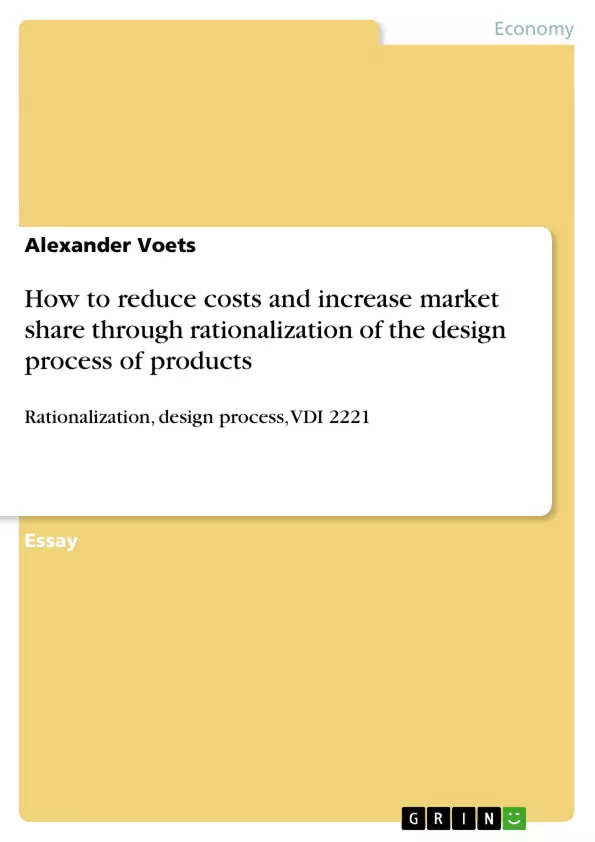As the competitive environment rises and the life cycle of a product decreases in length it becomes more and more important to develop products cost efficiently. Products do not yield profit for as long as they used to. Therefore the costs spent have to match the achievable outcome. Moreover, the technology pace harbors the risk that a product that went trough a long development process might already be outdated when it is ready for market emerge. Today’s companies face the challenge to provide quality products that are up to date and yet at a low price. The money spent on development and production has to be distributed wisely. The rationalization of the design process helps through various approaches to reduce the costs and still remain the products quality. This paper will examine the approach of applying rationalization to the design process. It will outline the potential of reducing costs and gaining market share through faster market emerge.
Inhaltsverzeichnis (Table of Contents)
- INTRODUCTION
- LIFE CYCLE OF A PRODUCT
- THE DESIGN DILEMMA
- HOW TO DESIGN NEW PRODUCTS - THE VDI 2221
- REDUCE COSTS THROUGH RATIONALIZATION
Zielsetzung und Themenschwerpunkte (Objectives and Key Themes)
This paper examines the approach of applying rationalization to the design process of products, aiming to demonstrate its potential for reducing development costs and achieving faster market emergence, ultimately leading to increased market share. The paper explores the impact of globalization and its effects on the design process.
- Rationalization of the design process
- Reducing development costs
- Achieving faster market emergence
- Increasing market share
- The impact of globalization on product design
Zusammenfassung der Kapitel (Chapter Summaries)
- INTRODUCTION: Introduces the concept of rationalization of the design process, emphasizing its importance in today's competitive market environment with fast-paced technological advancements. The chapter highlights the need to design products cost-efficiently and rapidly to remain competitive and achieve profitable market emergence.
- LIFE CYCLE OF A PRODUCT: Discusses the traditional three-phase product life cycle: market emergence, market introduction, and market presence. The chapter outlines the cost-revenue relationship throughout the different phases, emphasizing the need for efficient design to minimize costs during the initial stages and maximize profits during market presence.
- THE DESIGN DILEMMA: Explores the design dilemma, highlighting the discrepancy between the high impact of design decisions on product costs and the relatively low percentage of overall costs attributable to the design process itself. The chapter emphasizes the importance of rationalization to shorten the design process and gain a competitive advantage in time-to-market.
- HOW TO DESIGN NEW PRODUCTS - THE VDI 2221: Presents the VDI 2221 guideline, a structured approach to designing new products. This chapter outlines the different stages of the VDI 2221, including task clarification, function determination, solution principle identification, module structuring, and layout development. The chapter emphasizes the potential of rationalization measures to streamline this process.
- REDUCE COSTS THROUGH RATIONALIZATION: Explains the concept of rationalization and its role in reducing development costs, accelerating time-to-market, and gaining market share. The chapter highlights two key statements supporting the use of rationalization: avoiding iterative jumping back into previous process steps and focusing on routine work to minimize errors and improve efficiency.
Schlüsselwörter (Keywords)
Rationalization, design process, VDI 2221, development costs, market share, market emergence, globalization, time-to-market, product life cycle, design dilemma, efficiency enhancement, competitive advantage.
- Quote paper
- Alexander Voets (Author), 2009, How to reduce costs and increase market share through rationalization of the design process of products, Munich, GRIN Verlag, https://www.grin.com/document/152450



